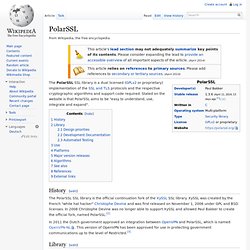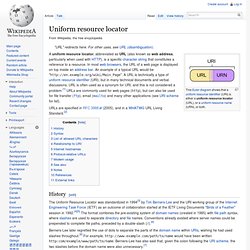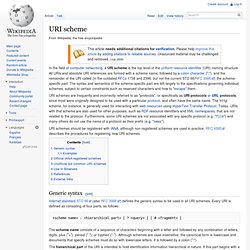

Alternative DNS. Cryptographic Hash. Magnet URI scheme. MetaLink. Pseudo dns. RFC 2168 - Resolution of Uniform Resource Identifiers using the Domain Name System. [Docs] [txt|pdf] [draft-ietf-urn-naptr] [Diff1] [Diff2] [IPR] Obsoleted by: 3401, 3402, 3403, 3404 EXPERIMENTALUpdated by: 2915 Network Working Group R.

Daniel Request for Comments: 2168 Los Alamos National Laboratory Category: Experimental M. Mealling Network Solutions, Inc. June 1997 Status of this Memo =================== This memo defines an Experimental Protocol for the Internet community. This memo does not specify an Internet standard of any kind. RFC 2168 Resolution of URIs Using the DNS June 1997 In addition to locating resolvers, the NAPTR provides for other naming systems to be grandfathered into the URN world, provides independence between the name assignment system and the resolution protocol system, and allows multiple services (Name to Location, Name to Description, Name to Resource, ...) to be offered.
RFC 2168 Resolution of URIs Using the DNS June 1997 meet the goals listed above. Transport Layer Security. Transport Layer Security (TLS) and its predecessor, Secure Sockets Layer (SSL), are cryptographic protocols designed to provide communications security over a computer network.[1] They use X.509 certificates and hence asymmetric cryptography to authenticate the counterparty with whom they are communicating,[2] and to exchange a symmetric key.

This session key is then used to encrypt data flowing between the parties. This allows for data/message confidentiality, and message authentication codes for message integrity and as a by-product, message authentication. [clarification needed] Several versions of the protocols are in widespread use in applications such as web browsing, electronic mail, Internet faxing, instant messaging, and voice-over-IP (VoIP). An important property in this context is forward secrecy, so the short-term session key cannot be derived from the long-term asymmetric secret key.[3] OpenSSL. History of the OpenSSL project[edit] The OpenSSL project was founded in 1998 to invent a free set of encryption tools for the code used on the Internet.

As of 2014 two thirds of all webservers use it. The OpenSSL project management team consists of 4 Europeans. The entire group consists of 11 members, of which 10 are volunteers, with only one full-time employee, Stephen Henson, the lead developer. The project has a budget of less than $1 million a year and relies in part on donations. PolarSSL. The PolarSSL SSL library is a dual licensed (GPLv2 or proprietary) implementation of the SSL and TLS protocols and the respective cryptographic algorithms and support code required.

Stated on the website is that PolarSSL aims to be "easy to understand, use, integrate and expand". History[edit] The PolarSSL SSL library is the official continuation fork of the XySSL SSL library. XySSL was created by the French "white hat hacker" Christophe Devine and was first released on November 1, 2006 under GPL and BSD licenses. In 2008 Christophe Devine was no longer able to support XySSL and allowed Paul Bakker to create the official fork, named PolarSSL.[2] In 2011 the Dutch government approved an integration between OpenVPN and PolarSSL, which is named OpenVPN-NL. Library[edit] Later versions of the SSL library (> PolarSSL 1.3.0) add abstraction layers for memory allocation and threading to the core "to support better integration with existing embedded operating systems".[4]
Uniform resource locator. A uniform resource locator, abbreviated as URL (also known as web address, particularly when used with HTTP), is a specific character string that constitutes a reference to a resource.

In most web browsers, the URL of a web page is displayed on top inside an address bar. An example of a typical URL would be " A URL is technically a type of uniform resource identifier (URI), but in many technical documents and verbal discussions, URL is often used as a synonym for URI, and this is not considered a problem.[1] URLs are commonly used for web pages (http), but can also be used for file transfer (ftp), email (mailto) and many other applications (see URI scheme for list).
URLs are specified in RFC 3986 (2005), and in a WHATWG URL Living Standard.[2] History[edit] Berners-Lee later regretted the use of dots to separate the parts of the domain name within URIs, wishing he had used slashes throughout.[6] For example, would have been written http:com/example/www/path/to/name. URI scheme. URI schemes should be registered with IANA, although non-registered schemes are used in practice.

RFC 4395 describes the procedures for registering new URI schemes. Generic syntax[edit] Internet standard STD 66 (also RFC 3986) defines the generic syntax to be used in all URI schemes. Every URI is defined as consisting of four parts, as follows: <scheme name> : <hierarchical part> [ ? The scheme name consists of a sequence of characters beginning with a letter and followed by any combination of letters, digits, plus ("+"), period (". "), or hyphen ("-"). The hierarchical part of the URI is intended to hold identification information hierarchical in nature.
The query is an optional part, separated by a question mark ("? ") Cryptology. DNS (Domain Name System) DNS (Unix & Linux) Merkle Tree. Related to Number Theory & Abstract Algebra. URLs.Strings (Programming) URLs (Strings - PowerShell) IP Concepts.